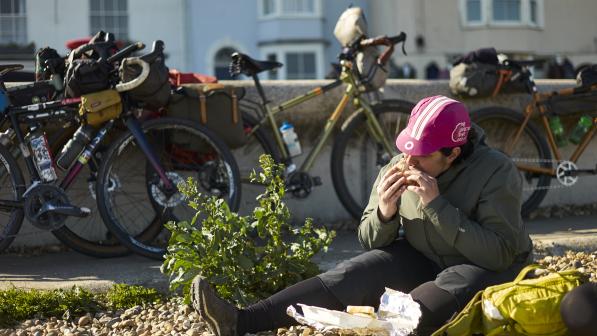Seven top tips to fuel your rides

Staying properly fuelled will help you to sustain your energy levels when riding your bike. Here are some top tips on what to eat before, after and during a ride.
1. Stick to a mainly whole foods-based diet
You’ll have the energy to do more exercise this way
Eat three to four meals per day, don’t skip meals and avoid very low calorie diets. Each plate should consist of 25% carbs, 25% protein and 50% fruits and vegetables. This will provide you with a baseline of fuel, enable recovery, and make you less prone to injury and remain healthy.
2. Get the portion sizes right for each meal throughout the day
- A palm-sized portion of protein (approx 1.4-1.8g of protein per kilogram of bodyweight, per day, depending on the amount of exercise you’re doing) to keep you satiated and aid muscle repair and recovery
- A fist-sized portion of carbohydrates (approx 5-8g of carbs per kilogram of bodyweight, per day, depending on the amount of exercise you’re doing) to provide you with energy
- A cupped-hand-size portion of fruit and vegetables for fibre and health benefits from the micronutrients (you don’t want to be ill all the time and miss training!)
- A thumb-sized portion of fats to help tissue inflammation, hormone function and vitamin transportation

If you do a lot of exercise sessions during the week then in total, across the day you should be aiming to eat approximately 30% protein, 30% fats and 40% carbohydrates.
As you can see from this ratio, carbohydrates are required in higher amounts than the other macronutrients. They are the most efficient fuel source; we need them to give us the energy to cycle.
This needs to be delivered consistently throughout the day to ensure the energy is there when we need it.
There are only 4Kcal in each gram of carbohydrates, which is the same as protein (4Kcal per g). Carbohydrates are not the devil! There are 9Kcal per g of fat and 7Kcal per g of alcohol.
3. Pre-ride
Eat a well balanced meal around two hours before you head out
You should aim to include around 80-100g of carbohydrates in this meal.
Breakfast examples might be porridge with fruit and a scoop of protein powder, overnight oats with fruit and a Greek yoghurt, an omelette with spinach, or salmon on toast with spinach.
Go light on the fibre so that you don’t get gastrointestinal (GI) upset. Choose light foods which are energy dense.
You can use caffeine for a really effective boost. Try drinking 150-200mg of caffeine (a double espresso) 45 minutes before the ride.
Test what works for you, and doesn’t give you an upset stomach during the ride.
4. During the ride
Hydrate from the start, and well throughout.
Aim to drink one 750ml bottle per hour in sips throughout the ride.
Add some electrolytes to your drink to help your hydration – you can add electrolyte tablets or powder, or make your own using fruit juice, water and a little salt.
Caffeine tablets are also available to buy.
5. Fuelling on the ride
If your ride is longer than 60 minutes, you will need to consume some extra fuel
To give you the energy you need on the ride you need fast-acting carbohydrates, such as fructose. A banana or a jam sandwich are good options, as are flapjacks and protein balls (see the community member recipes on the Her Spirit app), as well as ready-made energy gels and carbohydrate drinks.
You should aim to consume around 30-60g of carbohydrates per hour, which is roughly half a flapjack or half a protein bar.
Don’t wait until you’re hungry or feeling the shakes; you need the carbohydrates before the muscles run out of fuel to make energy.
If your ride is less than 60 minutes you shouldn’t need extra fuel.
6. Post-ride fuelling
Aim to eat within two hours of returning from your ride
If this is your usual mealtime, eat a balanced meal with the correct portion sizes (see tips 1 and 2).
You may need to add extra carbs – an additional half a portion is a good place to start.
Try consuming fast-acting carbohydrates post-ride, such as white pasta or rice, or starchy vegetables. Fats are important too, as they help to reduce post ride inflammation in the muscles and joints.
If it’s going to be more than two hours before a meal once you’ve returned from your ride, have a portion of protein with some fats and carbohydrates to replace some of the energy you’ve used.
An example might be a protein shake with milk and fruit, or a small meal with white rice, vegetables and chicken (fourth meal of the day).
7. Rehydration post ride
Keep drinking until your urine is clear
Milk is a great hydration tool as it includes protein, carbohydrates and minerals to replace lost electrolytes.
At HER Spirit we believe in the KISS and the 80/20 rules – KISS stands for Keep It Simple Stupid!
Don’t overcomplicate your fuelling strategies, stick to the basics of a balanced plate with whole foods, eat healthily 80% of the time, and you’ll have plenty of energy to enjoy your rides.
Eat enough food to feel energised both throughout the day and while riding.
If you find you are feeling fatigued, slow to recover, are easily injured or losing weight quickly, this is an indication that you need to fuel more, probably from carbohydrates, sleep well and stay hydrated.
If you want to train like an athlete and have plenty of available energy, you need to fuel and recover like one.



